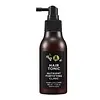What's inside
What's inside
 Key Ingredients
Key Ingredients

 Benefits
Benefits

 Concerns
Concerns

 Ingredients Side-by-side
Ingredients Side-by-side

Water
Skin ConditioningAlcohol
AntimicrobialGlycerin
HumectantCaprylic/Capric Triglyceride
MaskingBiotin
AntiseborrhoeicCeramide NP
Skin ConditioningPanthenol
Skin ConditioningPropanediol
SolventAdenosine
Skin ConditioningMentha Piperita Oil
MaskingSerenoa Serrulata Fruit Extract
Skin ConditioningAllantoin
Skin ConditioningGanoderma Lucidum Extract
Skin ProtectingPanax Ginseng Root Extract
EmollientCaffeic Acid
AntioxidantRosmarinus Officinalis Leaf Extract
AntimicrobialEcklonia Cava Extract
Skin ConditioningUrtica Dioica Leaf Extract
Skin ConditioningRhodiola Rosea Root Extract
EmollientDioscorea Japonica Root Extract
Skin ConditioningPaeonia Lactiflora Root Extract
Skin ConditioningZingiber Officinale Root Extract
MaskingSophora Flavescens Extract
Skin ConditioningCaprylyl Glycol
EmollientLecithin
Emollient1,2-Hexanediol
Skin ConditioningEthylhexylglycerin
Skin ConditioningPolysorbate 80
EmulsifyingPEG-60 Hydrogenated Castor Oil
EmulsifyingDisodium EDTA
Citric Acid
BufferingSodium Citrate
BufferingParfum
MaskingWater, Alcohol, Glycerin, Caprylic/Capric Triglyceride, Biotin, Ceramide NP, Panthenol, Propanediol, Adenosine, Mentha Piperita Oil, Serenoa Serrulata Fruit Extract, Allantoin, Ganoderma Lucidum Extract, Panax Ginseng Root Extract, Caffeic Acid, Rosmarinus Officinalis Leaf Extract, Ecklonia Cava Extract, Urtica Dioica Leaf Extract, Rhodiola Rosea Root Extract, Dioscorea Japonica Root Extract, Paeonia Lactiflora Root Extract, Zingiber Officinale Root Extract, Sophora Flavescens Extract, Caprylyl Glycol, Lecithin, 1,2-Hexanediol, Ethylhexylglycerin, Polysorbate 80, PEG-60 Hydrogenated Castor Oil, Disodium EDTA, Citric Acid, Sodium Citrate, Parfum
 Reviews
Reviews

Alternatives
Ingredients Explained
These ingredients are found in both products.
Ingredients higher up in an ingredient list are typically present in a larger amount.
Ginseng root is a well-loved ingredient in Asian skincare for good reason. It hydrates the skin, soothes irritation, and helps even out skin tone.
In traditional East Asian medicine, ginseng has been used for centuries both as food and as a healing remedy, and modern research continues to confirm its skin benefits.
One of the standout features of ginseng is its ability to improve blood circulation and oxygen delivery to the skin, bringing a fresh supply of nutrients to support overall skin health. It also has antioxidant and anti-inflammatory properties. This helps to protect your skin against damage from UV exposure, pollution, and daily stress.
Additionally, studies suggest that ginseng may help reduce hyperpigmentation by inhibiting tyrosinase, the enzyme involved in melanin production.
There are different types of ginseng used in skincare, and while they all share core benefits, their potency can vary.
Most products use fresh or white ginseng because it’s more affordable. However, red ginseng, produced by steaming the root, contains higher levels of ginsenosides, which are compounds with proven anti-aging effects. These ginsenosides help reduce the appearance of wrinkles and improve skin elasticity.
Note: All forms of ginseng are listed simply as “Panax ginseng” in ingredient lists. We recommend reaching out to the brand if you have questions about which type of ginseng is used in their ingredients.
For general antioxidant benefits, any ginseng extract will do, but for wrinkle care or firmer skin, red or fermented ginseng is often more effective.
In short, ginseng is a powerhouse ingredient that supports hydration, radiance, and resilience.
Learn more about Panax Ginseng Root ExtractPanthenol is a common ingredient that helps hydrate and soothe the skin. It is found naturally in our skin and hair.
There are two forms of panthenol: D and L.
D-panthenol is also known as dexpanthenol. Most cosmetics use dexpanthenol or a mixture of D and L-panthenol.
Panthenol is famous due to its ability to go deeper into the skin's layers. Using this ingredient has numerous pros (and no cons):
Like hyaluronic acid, panthenol is a humectant. Humectants are able to bind and hold large amounts of water to keep skin hydrated.
This ingredient works well for wound healing. It works by increasing tissue in the wound and helps close open wounds.
Once oxidized, panthenol converts to pantothenic acid. Panthothenic acid is found in all living cells.
This ingredient is also referred to as pro-vitamin B5.
Learn more about Panthenol